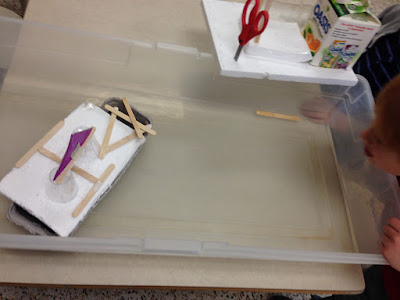by Stephanie Bartlett
A play-based program is the ultimate backdrop for the most incredible learning opportunities. It is our job as educators to pay attention and listen carefully. As facilitators, we can then offer tools and experiences for students to become mindful learners, all in the midst of play. Take boats, for example.
Over the course of the last couple of months, B, H and C have often sat and drawn pictures of boats. We have hung them on the wall near our water table and I have waited for the right moment to take their learning to a deeper level. It all came together this week when many students were involved in a pirate game. They created treasures to hide and drew maps for everyone to take part. (Hello, collaboration!!) For two days, I watched and listened carefully, wondering how to decide the best way to guide their thinking. I asked my three students to sit the next day and draw plans for boats they could build. Their plans initiated a class discussion about motor boats and sail boats, and pirate ships, of course!
B went to the next step and created a materials list.
The next day, B arrived and spent a large amount of time building a model boat out of popsicle sticks, telling me "I thought and thought at home about how I could build a boat with buttons, popsicle sticks and string. This boat collects garbage on the ocean and I need to build a claw on the back."
Coincidentally, my colleague mentioned earlier in the week that she had many students who were very taken with machines, motors and boats in particular. There was my point of convergence. We could create boats together! As a team, we have decided to offer the opportunity to students in all three of our kindergarten classes to work together. Today, we had two parent volunteers come in and set up an area with materials, paper and writing tools to draw plans and a tub of water to test for seaworthiness. Knowing that sparks catch fire, we started this idea with the interest of a few students, knowing that others would jump on board, so to speak. The environment was focused and highly engaged. There was a quiet hum of happiness and excitement, peppered with observations, in the most natural form of analytic thinking and feedback.
"I think your boat is leaning too far to one side."
"How can I get my boat to move?"
"You need some wind. Can you blow?"
"Mine is sinking."
"My boat is heavy on one side. It keeps leaning."
Some students drew plans and then proceeded to build without referring to their plan. There is an interesting focus point for the next projects, always keeping in mind that some learners are unable at this point to articulate what their plan is before they execute and we believe that is ok.
Others, drew their plans and build their boats accordingly.
Genius Hour has been very fluid in my class this year. My original intent was to spend every Friday morning engaged in different projects. In the ever-changing world of Kindergarten, if students are protopying an idea or developing an idea, they are not all going to put it away until the following week...they will keep playing until they are ready to discover new things or play with different people. So, on Fridays when I have two parent volunteers, I now create the space and provide the materials for students who are experimenting with certain ideas.
As educators, we can help students discover new concepts and play with intention. Teaching without themes in the traditional sense of the word is perhaps best understood through the lens of creative development. The vocabulary and disposition of creative development is the common thread that helps my students to open their minds and apply the skills we are learning in a very real context that is relevant to them.
What's next? On Monday morning, when the students enter the room, their boats will be waiting for them. Will they return to their boats and continue tweaking their models? Will others have decided that they would like to build another prototype? Will they play with their boats in the water table? Will some draw another picture or write a story? Will they naturally group the different types?
One thing is certain: I will be nearby, listening to the feedback and analytical development and watching the magic of engaged students, waiting for the next possible spark.















 Erin Quinn
Erin Quinn









Be First to Post Comment !
Post a Comment